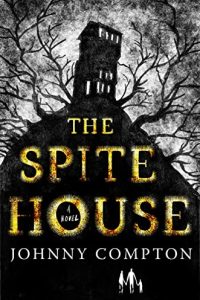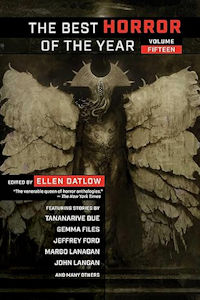Paul Di Filippo reviews Michael Blumlein
 Like his younger, award-winning counterpart Ted Chiang, Michael Blumlein is an uncommon artist of relatively sparse productivity (being a fulltime physician, which is Blumlein’s case, will do that to you), whose every rare story is eagerly anticipated and received for its meticulous, polished perfection and guaranteed quota of unparalleled astonishment. In a career stretching back nearly thirty years, this latest offering from Dr. B. constitutes only his sixth book. Of course, in mainstream literature, six books in thirty years is actually pretty common and accepted career stats. It’s only in the field of fantastika, with its lingering emphasis on pulp productivity, that such a bibliography looks paltry. Perhaps Blumlein is simply writing with the due consideration and careful thought and craftsmanship that hastier writers fail to deploy.
Like his younger, award-winning counterpart Ted Chiang, Michael Blumlein is an uncommon artist of relatively sparse productivity (being a fulltime physician, which is Blumlein’s case, will do that to you), whose every rare story is eagerly anticipated and received for its meticulous, polished perfection and guaranteed quota of unparalleled astonishment. In a career stretching back nearly thirty years, this latest offering from Dr. B. constitutes only his sixth book. Of course, in mainstream literature, six books in thirty years is actually pretty common and accepted career stats. It’s only in the field of fantastika, with its lingering emphasis on pulp productivity, that such a bibliography looks paltry. Perhaps Blumlein is simply writing with the due consideration and careful thought and craftsmanship that hastier writers fail to deploy.
Blumlein’s prefered mode is fabulism, a blend of the Three Faces of Fantastika — Fantasy, Horror, and Science Fiction. Laid of course atop a foundation of actinic naturalism. The ratios shift and flow from story to story. Tone varies from downright scary to wistfully melancholy to surreally absurd. Some pieces approach pure fantasy, others pure terror, and others the hard-edged realm of SF. At various times, Blumlein’s work will remind you of Borges and Koja, Aickman and Ballard, Disch and Kafka, Ligotti and Gibson. But after sufficient immersion, you will recognize the pure, unique, infectious Blumleinian strain that encompasses all of these, and more.
Before trying to convey a little of the nonpareil flavor of these tales, let me declare that this book by Centipede Press is one of the most gorgeous examples of the bookmaking craft I’ve held in a long time. Solid heavy boards; attached fabric-ribbon bookmark; lush paper; vibrant, easy-on-the-eyes typography; full-color interior plates (art by Brian McCarty); and just a splendid overall sense of design. Plus a perceptive introduction by Rudy Rucker which probably renders my review superfluous.
The first story, “Twenty-Two and You,” revolves, as so many of Blumlein’s do, around biology. (Blumlein is my ribofunk homeboy.) A woman bearing a potentially fatal gene for cancer undergoes an experimental treatment which produces highly ironic results. In the unraveling of the woman’s marriage, Blumlien shows his depth of insight into affairs of the heart right off the bat.
“California Burning” is an absurdist laugh-or-cry tale about a son attempting to dispose of the imperishable corpse of his father, and what the son learns about himself and his Dad. “Whoever my father was and wherever he came from, the earth had him now. But we had him before, and without question he had us.” A living legend, Paul Bunyan, occupies center stage in the revisionist and touching “Paul and Me.” Here we start to see Blumlein’s proclivity for sexual transgressiveness. The ghost of a prematurely born girl—able to converse like an adult—haunts the father of the child in “Revenge,” a story which illustrates that sometimes hatred and obsession can be turned inside-out to produce a blessing.
“Snow in Dirt” is, on one level, a skewed, gonzo reimagining of the Snow White scenario. A young man, Martin, literally digs up a sleeping, breathing woman, awakes her, and has a long rollercoaster lifetime with her, all rendered with pitch-perfect deadpan realism. But Blumlein also layers in elements of the Golem myth, as well as meditations on modern fame and celebrity, making for an even richer experience.
Blumlein’s facility for creating natural, engaging dialogue is just one of his talents on display in “The Big One.” Four pals on a fishing trip shoot the bull, contend amiably and rivalrously amongst themselves—and then face a mortal moment of challenge. “Hymenoptera” concerns a fashion designer and his insectile inspiration—and the perishability of art. “Greedy for Kisses” emerges as a short, utopian prose poem about mysterious visitors whose tactics of conquest, if such be their goal, is nothing more than a simple kiss.
Like some mad allegory by Isaac Bashevis Singer, with Judaism as one key component, “Fidelity: A Primer” charts the bizarre married life of Lydell and Judith, whose opposing views on duty and love somehow ultimately converge, amidst tsuris and misunderstandings.
In the New England coastal town of Aponeset—charmingly and authentically rendered—a woman named Sharon finds her family’s dramas ineluctably tied to the lovingly inhabited geography and clime. That’s “Isostasy,” which produces an air of James Blaylock combined with Robert Frost. “Strategy for Conflict Avoidance: Memo to George W, Our Commander-in-chief” has one of the best opening lines in the book: “If you watch an animal long enough, it’s going to fornicate.” Beyond that beginning, the story is a small but substantial parable about ways and limits of knowing.
“Bird Walks in New England” might remind the reader of a Carol Emshwiller story, with its forlorn yet buoyant female protagonist, whose sighting of a strange creature resonates with a fateful stranger. Published also as a standalone novella, “The Roberts” inhabits a creepy landscape of mad genius love and ambition, following the intertwined careers of two exceptional men. And finally, “Know How, Can Do” is the black-humored account of a strange hybrid thing bred in a lab and its quasi-romantic attachment to its creator, as well as its hopes for a larger life. In a lateral way—and I give a clue to the nature of the hybrid narrator here—it’s like Vernor Vinge’s “Bookworm, Run!”.
Emerging from Blumlein’s new book is rather like being born all over again. The reader is bloody, beslimed and shocked, but the whole world looks as if it were just created.








makes one want to rush out, buy this book, find a grassy spot under a tree and with wine and cheese and Blumlein’s new book; have a glorious day!
great review, Paul.